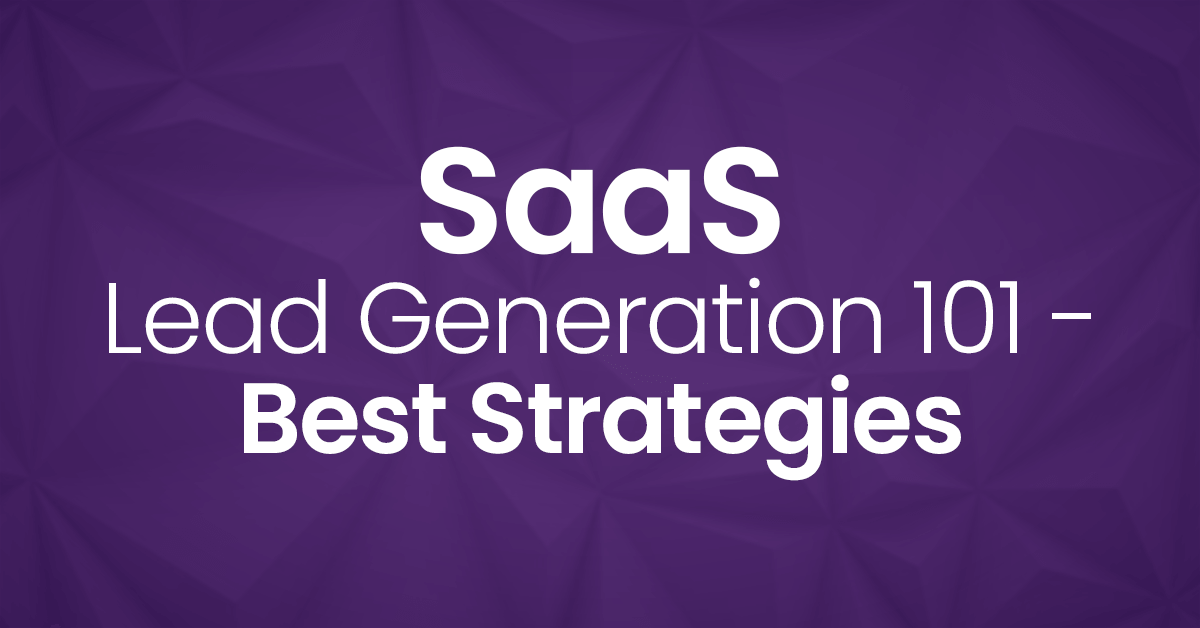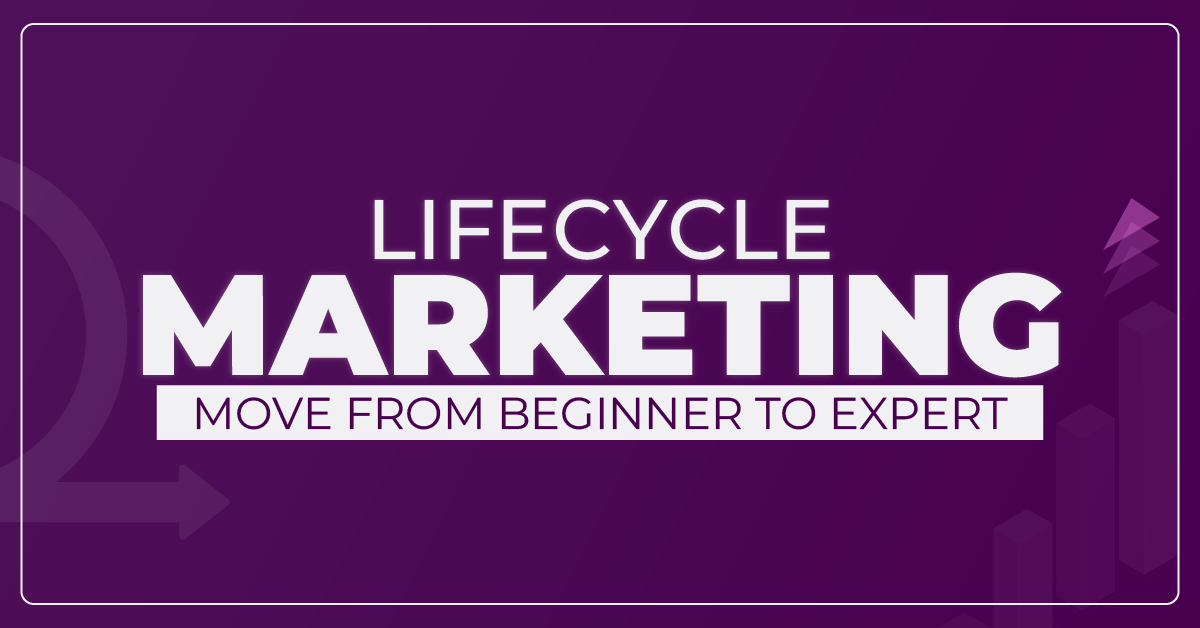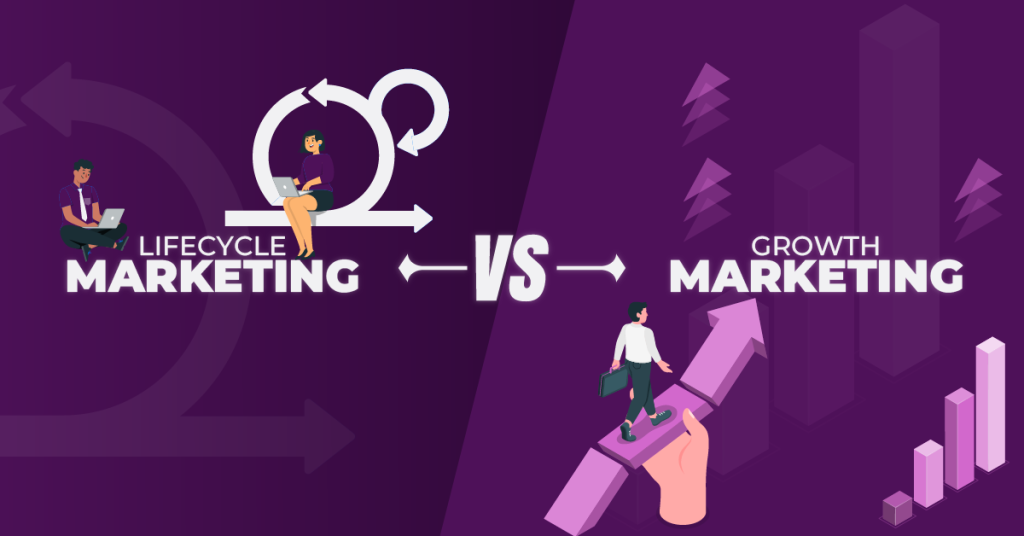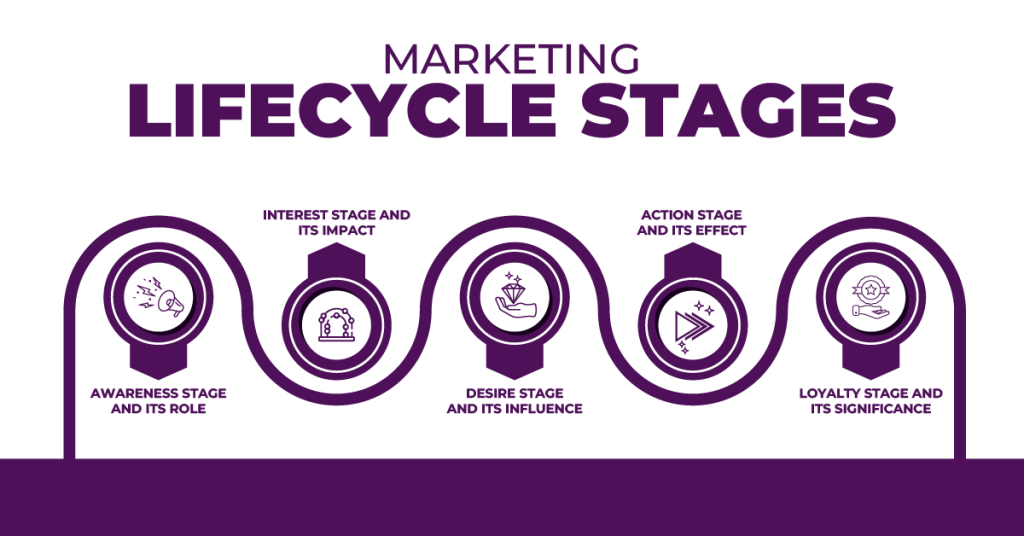Effective lead generation is integral to sustaining growth and generating revenue in the highly competitive Software as a Service (SaaS) landscape. SaaS Lead Generation 101: Best Strategies discusses effective methods for attracting and converting prospects into customers in the SaaS context. With effective strategies, SaaS companies can continue producing qualified leads, which will increase sales and long-term growth of their business.
This guide will outline the best lead generation strategies for SaaS, considering the different challenges and opportunities within the SaaS space. Limited to setting the stage, whether you are at the beginning of your journey or looking to review what you have done to date, you will find methods to effectively lead-generation in the ever/increasingly competitive space.
In the SaaS sales funnel, lead generation plays a crucial role, as it fuels prospects’ journey from initial awareness to final conversion. SaaS engines depend on a constant supply of leads, regardless of how efficiently designed they are.
Therefore, businesses that want to thrive in a competitive environment must master the art of lead generation. Engaging potential clients at the top of the sales funnel and nurturing them through conversion is what transforms a static service into a dynamic one.
What is Lead Generation for SaaS Companies?
Lead generation is a strategic process of identifying and cultivating potential customers for your digital offerings in the digital ecosystem of SaaS (Software as a Service). In contrast to traditional businesses that rely on face-to-face interactions and physical product demonstrations, SaaS companies operate in a virtual environment, with initial customer engagement often taking place online. Consequently, attracting leads and nurturing them to convert them into paying subscribers requires a different approach due to this unique environment.
Customer interaction with SaaS products typically takes place via online channels, such as organic search, social media platforms, or targeted advertising. The goal is to attract quality leads who show a genuine interest in the service provided. SaaS lead generation leverages the advantage of digital product demos and the offering of free trials.
It is possible to test the software without any commitment with these methods, creating a more informed and potentially willing buyer when direct contact is made. As a result of the self-service nature of the SaaS model, lead generation is streamlined and consumers prefer independent product evaluations.
What is Lead Generation, Why It’s So Important for SaaS Businesses?
A lead generation process involves attracting and converting strangers and prospects into those who have expressed interest in your company. Due to the nature of the digital product offering and the highly competitive market landscape, lead generation is important for SaaS businesses. By continuously attracting and engaging potential customers, SaaS companies can ensure their survival and thrive in the digital economy.
Sustained Business Growth:
A subscription-based SaaS model requires continuous customer acquisition. Lead generation ensures a steady stream of potential customers entering the sales funnel.
Building Customer Base:
It is vital to generate new leads since SaaS products often rely on monthly and annual subscriptions. It compensates for customer churn and drives recurring revenue.
Market Expansion:
Using effective lead-generation strategies helps SaaS companies expand their reach and uncover new revenue streams by tapping into new markets and demographics.
Product Validation and Feedback:
By interacting with prospects, product development can be informed by market needs and product reception, ensuring that the offering remains relevant and competitive.
Cost-Effectiveness:
For SaaS companies with limited marketing budgets, but the need to scale rapidly, digital lead generation strategies offer a higher ROI.
Customer Lifetime Value:
To ensure long-term profitability, effective lead generation helps identify prospects with the highest lifetime values.
Competitive Advantage:
Companies that excel at lead generation and conversion stand out in the crowded SaaS marketplace and capture a larger share of the market.
What are the Different Categories of SaaS Lead Generation Strategies?
SaaS lead generation can be categorized into several key strategies, each leveraging different channels and methodologies to attract potential customers. Understanding these categories is crucial for SaaS companies to tailor their approach effectively and capture a diverse audience. Here are the primary categories:
1. Content Marketing
Creating relevant, valuable content addressing the needs and questions of the target audience is part of this strategy. To build trust and authority in the market, blogs, white papers, e-books, and infographics are common formats used to attract leads by providing useful information.
With Design Shifu, you will be able to boost your SaaS lead generation campaign by creating compelling infographics, engaging blogs, and informative e-books that will engage your audience and elevate your content marketing strategy. Start attracting more leads today and see how professionally designed content can help you build trust and authority in your market.
Transform your content into a lead-generation powerhouse with Design Shifu!
With our unlimited design requests and revisions, rapid turnaround times, and dedicated professional designers, we ensure your content not only looks professional but also drives results.
2. Search Engine Optimization (SEO)
SEO involves optimizing your website and content to rank higher in search engine results for keywords relevant to your SaaS product. This organic method is crucial to generating leads actively searching for your software.
3. Pay-Per-Click (PPC) Advertising
PPC is a model of Internet marketing where advertisers pay a fee each time one of their ads is clicked. Instead of attempting to earn visits organically, you buy those visits. PPC channels for SaaS companies include Google Adwords and social media advertising via LinkedIn and Facebook.
4. Social Media Marketing
Through social media platforms, your SaaS product can be promoted, potential customers can be engaged with, and content that resonates with your target audience can be shared. With Twitter, LinkedIn, and Facebook, you can leverage their vast user base to build brand awareness and generate leads.
5. Email Marketing
By nurturing leads with targeted content, product updates, and special offers, email campaigns can help move potential customers down the sales funnel.
“Take your email marketing to the next level with Design Shifu!” Enhance your lead nurturing process with beautifully designed email campaigns that capture attention and drive action. From targeted content and product updates to irresistible special offers, Design Shifu ensures your emails stand out in a crowded inbox.
With our expertise in creating visually compelling email designs, coupled with unlimited requests and revisions, we’re here to help you convert potential customers into loyal ones. With Design Shifu, you can boost your email marketing strategy and move leads down the sales funnel more effectively. Click here to learn more about our services and start transforming your email campaigns today!”
6. Referral Marketing
Through referral programs, existing customers can refer new users to your SaaS platform, capitalizing on word-of-mouth and trusted recommendations.
7. Event Marketing
Attending webinars, workshops, and conferences can help you generate high-quality leads. These events allow you to demonstrate your expertise, network with potential customers, and engage directly with them.
What are SaaS Lead Generation Benchmarks?
By tracking these benchmarks, SaaS companies can identify areas of strength and opportunities for improvement in their lead generation strategies, ensuring they allocate resources effectively to maximize ROI and drive growth.
Conversion Rate:
Measures the number of visitors to your website who take a desired action, such as signing up for a free trial, filling out a contact form, or downloading content.
Cost Per Lead (CPL):
Businesses can determine the efficiency of their lead acquisition spending by dividing all marketing and advertising expenses by the number of leads generated.
Lead-to-Customer Rate:
An indicator of how well lead nurturing and sales processes convert leads into paying customers.
Time to Conversion:
During the sales cycle, the average time it takes for a lead to move from initial contact to becoming a customer.
Lead Volume Growth:
Measures the growth in the number of leads generated over a specific period. This benchmark indicates the scalability of lead generation efforts.
Lead Quality:
An analysis of the quality of leads based on predefined criteria, such as engagement level, fit, and likelihood to purchase.
Robust Strategies for SaaS Lead Generation In 2024
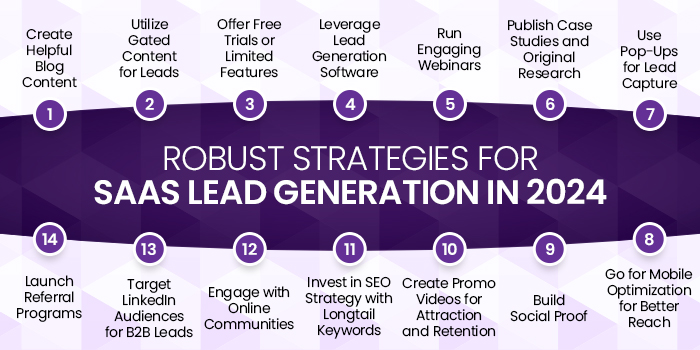
You can increase your pool of potential customers significantly with these strategies, ensuring the long-term success of your SaaS business and driving growth.
Create Helpful Blog Content
To establish your brand as a thought leader and attract organic traffic to your site, you need to develop informative and engaging blog content that addresses the pain points and interests of your target audience.
Utilize Gated Content for Leads
A form fill can be used to capture lead information by offering valuable resources such as whitepapers, e-books, or industry reports.
Offer Free Trials or Limited Features
Free trials and limited features can entice prospects to sign up and experience the benefits of your solution firsthand.
Leverage Lead Generation Software
Your efforts will be more efficient and effective if you invest in lead-generation software.
Run Engaging Webinars
Webinars on relevant topics not only position your brand as an authority but also allow you to engage directly with potential leads.
Publish Case Studies and Original Research
By sharing case studies and original research, you can demonstrate your solution’s tangible impact and build credibility.
Use Pop-Ups for Lead Capture
A well-placed pop-up form on your website can be a powerful tool for capturing lead information.
Go for Mobile Optimization for Better Reach
In a world increasingly dominated by mobile devices, it is crucial to make sure your website and content are mobile-friendly.
Build Social Proof
Showcasing customer testimonials, user reviews, and endorsements can enhance your brand’s trustworthiness and encourage more sign-ups.
Create Promo Videos for Attraction and Retention
Your product’s features, benefits, and user experience can be highlighted in promotional videos to attract and retain customers.
Invest in SEO Strategy with Longtail Keywords
The optimization of your search engine results with longtail keywords can increase your visibility and generate more qualified leads.
Engage with Online Communities
Online forums, discussion groups, and social media communities can help you connect with potential leads.
Target LinkedIn Audiences for B2B Leads
The LinkedIn network is a valuable channel for B2B SaaS companies to reach potential customers.
Launch Referral Programs
You can generate high-quality leads by encouraging current customers to refer new leads.
Essential Tools In SaaS Lead Generation

Leveraging these tools can significantly enhance your lead generation strategy, giving you a competitive edge in the SaaS market.
LeadFuze
A powerful lead generation software, LeadFuze automates the process of finding, contacting, and engaging potential leads. Using it, you can target leads based on industry, roles, technology used, and more, making it easier to create highly targeted outreach campaigns.
UpLead
With features such as real-time email verification and advanced search filters, UpLead enables you to find high-quality leads and directly connect with decision-makers.
DealFront
A relatively new player in the lead generation market, DealFront offers a suite of tools to streamline sales. Using actionable insights and targeted opportunities, it helps sales teams close deals faster by staying ahead of the competition.
ScopeLeads
As a lead generation tool for digital marketing services, ScopeLeads identifies businesses in need of SEO, social media, web design, and other services. By automating the process of finding and approaching potential clients, time is saved and efficiency is increased.
ZoomInfo
The ZoomInfo B2B contact database provides detailed information about businesses and professionals. Marketing and sales campaigns can be targeted at the most promising leads using extensive data on industries, company sizes, and job functions.
Frequently Asked Questions:
What is B2B SaaS Lead Generation?
B2B SaaS lead generation is the process of identifying and attracting potential business customers for software-as-a-service products, focusing on creating interest and converting businesses into leads
How Do I Generate B2B Leads for SaaS And Software Companies?
Generate B2B leads for SaaS by leveraging targeted content marketing, engaging in strategic social media campaigns, utilizing SEO, offering free trials/demos, and conducting insightful webinars.
How Can I Increase the Quality of Leads Generated Through SaaS?
Improve lead quality by refining your targeting criteria, nurturing leads with personalized content, and employing lead scoring to focus on prospects most likely to convert.

